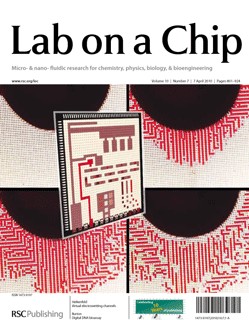
WATCH: A Lab-on-a-Chip With Moveable Channels
Microfluidic devices typically depend upon electrokinetic or traditional pressure methods to move microscopic amounts of fluid around a fixed microchip.
As just published as the cover story in
Lab on a Chip
, in
Virtual electrowetting channels: electronic liquid transport with continuous channel functionality
, engineering researchers at the University of Cincinnati have created a paradigm shift and moved some tiny channels in the process.
Lab on a Chip is the top journal in the microfluidics community, with an acceptance rate of less than one out of three, says Ian Papautsky, one of the papers authors.
The field of microfluidics has been intensely investigated for nearly two decades, being traditionally explored within fixed geometries of continuous polymer or glass microchannels. None of the prior approaches was capable of creating any desired channel geometry and being able to keep that channel configuration intact without external stimulus.
With that capability, electrically induced channel functions could bridge the gap between the worlds of programmable droplet and continuous flow microfluidics.
Someone just bridged that micromoat.
"So here we are working on displays, and creating cutting-edge techniques at moving colored fluids around, and we nearly overlooked the possibilities in lab-on-a-chip or biomedical areas, says Jason Heikenfeld, director of UCs
and an associate professor of electrical engineering in UCs College of Engineering and Applied Science. Heikenfeld has been making a name for himself and UC in the fields of photonics and
electrofluidic display technology
.
This is where collaboration comes into play, Heikenfeld continues. Here at UC we have several internationally known experts in microfluidics and lab-on-a-chip devices. We started collaborating with one of them, Ian Papautsky, and now we find ourselves in the middle of an exciting new application space."
In microfluidics, we typically work with either continuous flows which give us high throughputs or droplets (digital flows) that can be manipulated electrically, says Papautsky, associate professor of electrical engineering. Papautsky is also director of UCs
and director of the Micro/Nano Fabrication Engineering Research Center. In our new collaboration with Jason Heikenfeld, we are merging these two paradigms into a programmable microfluidic system. This is especially exciting because traditionally all lab-on-a-chip devices are limited by the predefined microchannel structure. A programmable microfluidics platform would offer an ability to reconfigure microchannel structure as needed for performing a wide range of biomedical assays, from DNA analysis to immunoassays, on the same chip.
I am excited to see our work so well received, Papautsky adds.
Virtual electrowetting channels: electronic liquid transport with continuous channel functionality, Lab on a Chip, by Manjeet Dhindsa, Jason Heikenfeld, Seyeoul Kwon, Jungwon Park, Philip D. Rack and Ian Papautsky
This work was funded by NSF CBET Award #0729250 and NSF CAREER Award #0640964. A portion of this research was conducted at the Center for Nanophase Materials Sciences, which is sponsored at Oak Ridge National Laboratory by the Division of Scientific User Facilities, U.S. Department of Energy.
Related News
Make Brighter, Full-Color Electronic Readers? Brilliant!
Electrofluidic Display Technology developed at the University of Cincinnati puts electronic book readers ahead by a wide margin.
Signs of Things to Come in Display Technology
In the home of the history of signs, the University of Cincinnati and Transitions Digital Graphics unveiled the future of sign technology.
Dynamic See-Through Display Technology Sheds Light on Sign Industry
UC and Transitions Digital Graphics introduce a novel transparent and emissive signage technology/product, a major innovation and entirely new medium for architectural design.
UC Engineering Research Widens Possibilities for Electronic Devices
NSF-funded engineering research on microfluidics at the University of Cincinnati widens the possibilities on the horizon for electronic devices.
2009 Emerging Entrepreneur Award: Chong H. Ahn
Faster diagnoses and more immediate test results are the desires of many patients and physicians. Chong Ahns innovative smart polymer lab-on-a-chip has opened a new door for point-of-care in vitro diagnostics to quickly analyze a persons health condition and status.
Related Stories
UC’s commercialization navigator pilots tech transfer at 1819...
July 25, 2024
Housed within the University of Cincinnati’s 1819 Innovation Hub, the Technology Transfer team is vital to safeguarding and managing the intellectual property generated by UC’s researchers. Its mission is to translate UC's cutting-edge innovations into viable technologies by evaluating patentability and commercial viability, ensuring compliance and legal protection, recruiting and maintaining external partners, marketing technologies, negotiating license deals and identifying funding opportunities. This multifaceted approach ensures that groundbreaking discoveries from UC are positioned to reach the market, delivering substantial benefits that impact society.
Don't like your voice? There's an app for that.
July 24, 2024
WVXU's Cincinnati Edition talks to UC College of Engineering and Applied Science Associate Professor Vesna Novak about her new voice-coaching app.
UC students win hackathon in San Francisco
July 22, 2024
With an app that combats food waste and incentivises donations to food banks, two University of Cincinnati students were part of a team that won an artificial intelligence and blockchain hackathon competition in San Francisco. Daniel Vennemeyer, a computer science, economics and mathematics student who also is pursuing a master’s degree in AI through UC’s ACCEND program, and Phan Anh “Rai” Duong, a computer science student, were part of a team that won the grand prize in the EasyA x VeChain Bay Area Hackathon.
